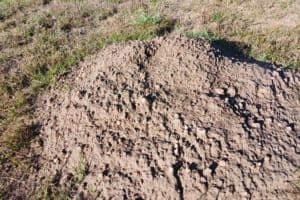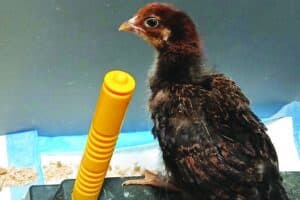To Bee or not to Bee
By Bill Radford
Way back in college, my wife, Margaret, got a B in her beekeeping class from professor Beagle (aka professor B) at Iowa State University.
If she had gotten an A, would our bees still be alive?
Likely not. For the second year, her hives did not survive the winter. But she’s hardly alone. In a nationwide survey by the nonprofit Bee Informed Partnership, beekeepers across the country lost 50.8% of their managed bee colonies from April 2020 to April 2021. (The loss slipped to a still significant 39% in the following 12 months.) And so-called backyard beekeepers consistently face higher losses than commercial ones.
The challenges confronting beekeepers are many, including disease and pests, most notably the Varroa mite. And Margaret has found particular challenges here on the Colorado prairie, from the extreme weather changes to a lack of forage, particularly during this time of drought.
Not that she hasn’t tried. I’ve seen her in the heat of summer, in the stifling confines of her protective bee suit, tending to the bees. She’s gotten advice from experts. We’ve planted flowers. She’s done mite control treatments, offered sugar water and pollen patties, provided protection from the elements. And still the losses.
Is she giving up? I’ll let her tell you:
It is fitting that black is the color of mourning because all I can see in my mind’s eye right now is thousands of worker bees and a queen dead somewhere in a sea of little black and yellow bodies on the hive’s white bottom board. No live bees clinging to frames. No contented buzzing. No warm fragrance of honey and wax, and no pineapple smell of alarm pheromones. Just dead bees.
I haven’t been able to bring myself to autopsy The Western Hive/aka Beyonce 3 Hive yet. I suspect from when they died — late January — and the lightness of the hive box that they starved. No honey left and I didn’t know. I failed to provide them with dry sugar “candy boards” in January and I bet that was it. Maybe I gave them sugar water too late in the fall and the condensation drowned them. But it could have been mites. At least I know it wasn’t the cold, because I wrapped their hives up in black plastic “cozies,” like the cozies we use for pop cans.
The Eastern Hive (Latifa 2) died a month earlier and there are almost no bee bodies left in it. I don’t know whether they flew off late in the fall or invading robber bees killed enough that the rest died slowly and the undertaker workers tossed the dead bodies out on the ground. But they had honey — and I have it now. Cold consolation.
So why do I do this? Beekeeping stimulates the senses. My heart pumps with excitement as 3,000 bees fall like snow out of a wooden shipping box to be installed in a hive. I got hot and sweaty as hundreds of cranky bees “swarm” me because I’ve opened the hive too early in the chilly morning. There’s the rhythmic sight of bees taking off and landing, like fighter jets, on a warm summer day; and the low, purposeful droning of a hive with a healthy queen vs. the high-pitched, panicked whine of a hive whose queen has died. Every sight, sound or smell means something.
And bees are a social experience. Each hive is different — each year, each season and each day. Each bee breed is different. My summer 2022 hives were relatively irritable Italians, so I could only work with them in the heat of the day when they were drunk on nectar. But any bees would seem cranky compared to the first year’s bees — Beyonce Hive 1 — which were super chill Carnolians. They gave me goofy waves and smiles as they buzzed by me in my flowery summer sundress — but they would circle, land and tenderly touch the fabric to see if I was in bloom. I wasn’t stung once that summer.
In three winters, we’ve made it through with live bees just once. It’s disheartening. And I’m not alone in feeling that; most of my hives and equipment I bought came from others who tried and gave up. I rarely get honey or wax. It seems like I always mess something up.
But for me, bees are something I can do for our planet. At least two swarms have left my hives over the years to pollinate our neighborhood. I admire bees’ clarity of roles — each bee knows her (or his, as with drones) job as it changes throughout its life. The queen knows her job most of all. Be mother to all. Bees cooperate seamlessly. And they remind me of what I love most about my work: being a member of a team unified by purpose. For bees, it’s find nectar and pollen. Raise baby bees. Try not to sting the nice lady in the sundress. And most of all, love the queen. No need for written job descriptions. It’s coded in the genes.
Right now my empty wooden hive boxes cry out to be cleaned (little black bodies buried) and filled again with life and love. I am still debating what to do. A friend has offered me safe harbor south of Colorado Springs, closer to water and agricultural crops rich with pollen and nectar. But it would be a long drive to check on them, and I won’t get to see them every day. I have friends whose hives do fine in our neighborhood, so I need to learn how they do it. Bee-ordering season is coming up. Do I order “packages” — 3,000 bees and their queen in a wooden box —- or do I order a miniature hive (with honey, pollen, babies and bees) known as a “nuc?” What I really want to do is volunteer with one of my mentors to “rescue” swarms on the lam. I don’t know. So many decisions. But I imagine what will bee, will bee.
Pull quote: There’s the rhythmic sight of bees taking off and landing, like fighter jets, on a warm summer day; and the low, purposeful droning of a hive with a healthy queen vs. the high-pitched, panicked whine of a hive whose queen has died. Every sight, sound or smell means something.
Caption:
Prairie Life bees:Margaret Radford tends to her bees. Photo by Bill Radford





